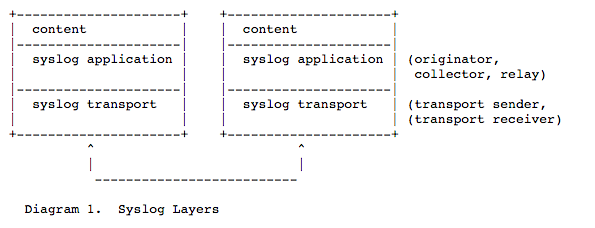Last updated at Tue, 03 Sep 2024 15:55:23 GMT
This post has been written by Dr. Miao Wang, a Post-Doctoral Researcher at the Performance Engineering Lab at University College Dublin.
This post is the first in a multi-part series of posts on the many options for collecting and forwarding log data from different platforms and the pros and cons of each. In this first post we will focus on Syslog, and will provide background on the Syslog protocol.
What is Syslog?
Syslog has been around for a number of decades and provides a protocol used for transporting event messages between computer systems and software applications. The Syslog protocol utilizes a layered architecture, which allows the use of any number of transport protocols for transmission of Syslog messages. It also provides a message format that allows vendor-specific extensions to be provided in a structured way. Syslog is now standardized by the IETF in RFC 5424 (since 2009), but has been around since the 80's and for many years served as the de facto standard for logging without any authoritative published specification.
Syslog has gained significant popularity and wide support on major operating system platforms and software frameworks and is officially supported on almost all versions of Linux, Unix, and MacOS platforms. On Microsoft Windows, Syslog can also be supported through a variety of open source and commercial third-party libraries.
Syslog best practices often promote storing log messages on a centralized server that can provide a correlated view on all the log data generated by different system components. Otherwise, analyzing each log file separately and then manually linking each related log message is extremely time-consuming. As a result, forwarding local log messages to a remote log analytics server/service via Syslog has been commonly adopted as a standard industrial logging solution.
How does Syslog work?
The Syslog standard defines three different layers, namely the Syslog content, the Syslog application and the Syslog transport. The content refers to the information contained in a Syslog event message. The application layer is essentially what generates, interprets, routes, and stores the message while the Syslog transport layer transmits the message via the network.

According to the Syslog specification, there is no acknowledgement for message delivery and although some transports may provide status information, the Syslog protocol is described as a pure simplex protocol. Sample deployment scenarios in the spec show arrangements where messages are said to be created by an ‘originator' and forwarded on to a ‘collector' (generally a logging server or service used for centralized storage of log data). Note ‘relays ' can also be used between the originator and the collector and can do some processing on the data before it is sent on (e.g. filtering out events, combining sources of event data).
Applications can be configured to send messages to multiple destinations, and individual Syslog components may be running in the same host machine.
The Syslog Format
Sharing log data between different applications requires a standard definition and format on the log message, such that both parties can interpret and understand each other's information. To provide this, RFC 5424 defines the Syslog message format and rules for each data element within each message.
A Syslog message has the following format: A header, followed by structured-data (SD), followed by a message.
The header of the Syslog message contains “priority”, “version”, “timestamp”, “hostname”, “application”, “process id”, and “message id”. It is followed by structured-data, which contains data blocks in the “key=value” format enclosed in square brackets “[]”, e.g. [SDID@0 utilization=“high” os=”linux”] [SDPriority@0 class=”medium”]. In the example image below, the SD is simply represented as “-“, which is a null value (nilvalue as specified by RFC 5424). After the SD value, BOM represents the UTF-8 and “su root failed on /dev/pts/7” shows the detailed log message, which should be encoded UTF-8. (For more details of the data elements of SLP, please refer to: http://tools.ietf.org/html/rfc5424)

Why Syslog?
The complexity of modern application and systems is ever increasing and to understand the behavior of complex systems, administrators/developers/Ops etc. often need to collect and monitor all relevant information produced by their applications. Such information often needs to be analyzed and correlated to determine how their systems are behaving. Consequently, administrators can apply data analytic techniques to either diagnose root causes once problems occur or gain an insight into current system behavior based on statistical analysis.
Frequently, logs have been applied as a primary and reliable data source to fulfill such a mission for lots of reasons, some of which I've listed here:
- Logs can provide transient information for administrators to roll back the system to a proper status after a failure accident. E.g. when a banking system fails, all transactions lost from the main memory can be recorded in the logs.
- Logs can contain a rich diversity of substantial information produced by individual applications to allow administrators/developers/ops teams to understand system behavior from many aspects such as current system statistics, trend predictions, and troubleshooting.
- Logs are written externally by the underlying application to hard disks and external services such that by reading these log files, there will not be any direct performance impact on the monitored system. Therefore, in a production environment administrators can safely monitor running applications via their logs without worrying about impacting performance.
However, a key aspect of log analysis is to understand the format of the arriving log data, especially in a heterogeneous environment where different applications may be developed using different log formats and network protocols to send these log data. Unless this is well defined, it is quite difficult to interpret log messages sent by an unknown application. To solve this issue Syslog defines a logging standard for different systems and applications to follow in order to easily exchange log information. Based on the logging protocol, Syslog helps applications effectively interpret each log attribute to understand the meaning of the log message.
